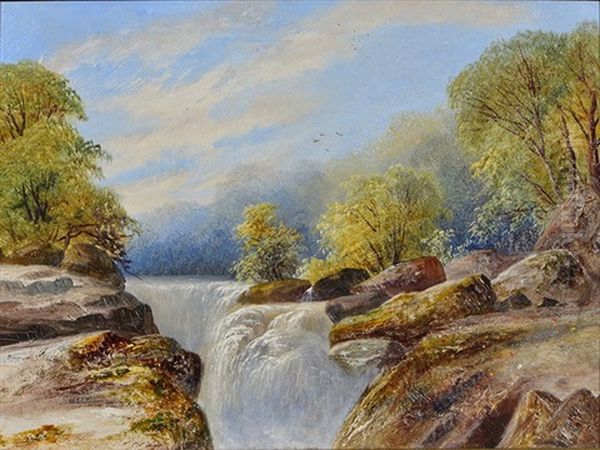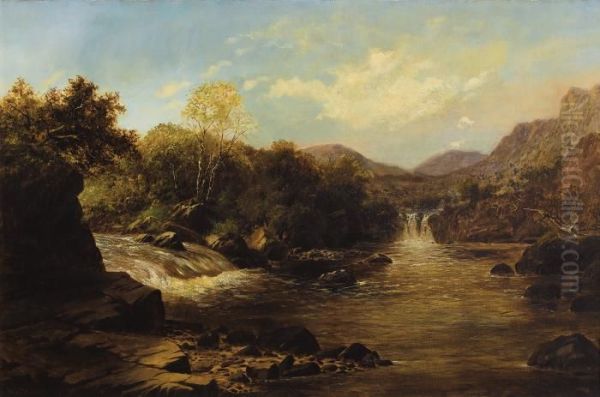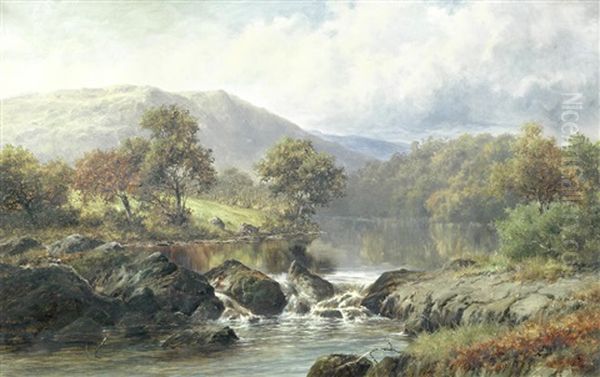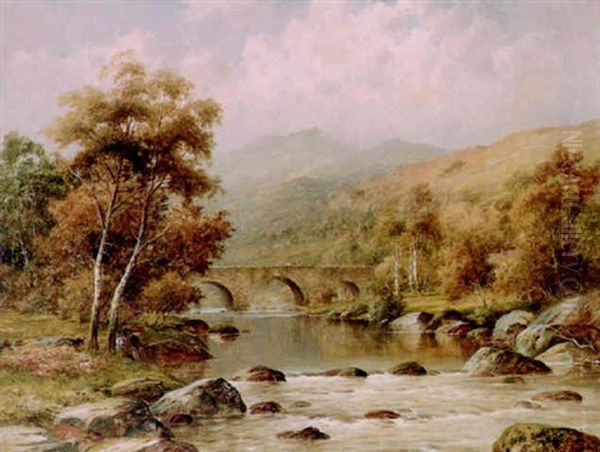William Henry Mander stands as a representative figure of late Victorian and Edwardian landscape painting in Britain. Active during a period of significant social and artistic change, Mander dedicated his career to capturing the tranquil beauty of the British countryside, particularly its woodlands, rivers, and rustic dwellings. Though biographical details remain somewhat scarce compared to the volume of his surviving work, his paintings offer a consistent vision of pastoral charm and technical competence that found favour with audiences of his time and continues to attract collectors today. Born in 1850 and passing away in 1922, his life spanned an era that witnessed the height of the British Empire, the challenges of industrialization, and the dawn of modernism, yet his art largely remained focused on the enduring allure of nature.
Understanding Mander requires placing him within the rich tradition of British landscape art. His work follows in a lineage deeply influenced by the observational skills of John Constable and the atmospheric drama of J.M.W. Turner. However, Mander operated in a later period, one where Victorian tastes often favoured detailed realism, narrative suggestion, and a certain picturesque sentimentality. His paintings provide a window into this sensibility, offering idyllic glimpses of rural England and Wales that resonated with a public increasingly living in urban, industrialized environments.
Life and Artistic Career
William Henry Mander was born in Birmingham in 1850. He remained closely associated with the Midlands throughout his life, particularly the vibrant artistic community in Birmingham. While detailed accounts of his personal life or artistic training are not widely documented, his professional activity is evidenced by his consistent output and exhibition record. He became a well-known figure in the regional art scene, contributing regularly to important exhibitions.

His primary venue for showcasing work appears to have been the Royal Birmingham Society of Artists (RBSA), where he exhibited frequently from the 1880s through the early 1900s. This society was, and remains, a significant institution for artists in the Midlands, providing a crucial platform outside of London. Exhibiting here allowed Mander to build a reputation and connect with patrons who appreciated his style of landscape painting. Records suggest he also exhibited occasionally at other venues, potentially including the Walker Art Gallery in Liverpool and possibly even the Royal Academy in London, though his strongest ties were with Birmingham.
Mander's career coincided with a period where landscape painting enjoyed immense popularity. The expansion of the middle class created a growing market for art that was accessible, relatable, and decorative. Scenes of the familiar British countryside, rendered with skill and evoking feelings of peace or nostalgia, were highly sought after. Mander successfully catered to this demand, producing a considerable body of work throughout his active years until his death in 1922. His dedication to his craft is evident in the consistent quality and recognizable style found across his numerous canvases.
The Victorian Landscape Context
To fully appreciate William Henry Mander's contribution, it is essential to understand the context of landscape painting in Victorian Britain. The genre held a preeminent position, building upon the foundations laid by earlier masters but evolving to reflect Victorian sensibilities. There was a profound cultural attachment to the countryside, often idealized as a repository of traditional values and natural beauty, standing in contrast to the rapid industrialization transforming towns and cities.
Victorian landscape painting often emphasized detailed observation, a legacy partly influenced by the Pre-Raphaelite Brotherhood's doctrine of "truth to nature," championed by artists like John Everett Millais and William Holman Hunt in their earlier phases. While Mander was not a Pre-Raphaelite, the general emphasis on careful rendering of natural elements – foliage, water surfaces, geological formations – is often visible in works from this period, including his. Accuracy was prized, often combined with a desire to create a pleasing, harmonious composition.
Furthermore, Victorian landscapes frequently carried implicit narratives or moral undertones. A rustic cottage might symbolize domestic virtue, a tranquil river scene could evoke contemplation, and ancient trees might suggest endurance. Mander's works, with titles often referring to specific, identifiable locations or featuring elements like homesteads and watermills, tap into this associative quality. They offered viewers not just a scene, but an experience connected to place, heritage, and the perceived stability of rural life. This contrasted sharply with the radical experiments in light and colour being undertaken by the Impressionists like Claude Monet and Camille Pissarro across the Channel, whose influence was slower to take hold in mainstream British art.
Artistic Style and Favoured Themes

William Henry Mander developed a distinctive and consistent style focused on the picturesque aspects of the British landscape. His primary medium was oil paint, applied with considerable technical skill to achieve both detail and atmospheric effect. His brushwork is generally controlled and descriptive, aiming for a high degree of finish that allows viewers to appreciate the textures of bark, stone, water, and foliage.
His colour palette tends towards naturalistic greens, browns, and blues, often imbued with a warm, gentle light. While he painted scenes in various seasons, he seems particularly adept at capturing the lushness of summer and the rich tones of autumn. The play of light is crucial in his work, whether it's sunlight dappling through leaves onto a forest floor, the reflection of trees in calm water, or the soft glow of late afternoon illuminating a rural scene. While perhaps not as dramatically focused on light effects as John Atkinson Grimshaw, Mander certainly understood its power to create mood and depth.
Mander's favoured subjects were consistently drawn from the natural and rural environment. He frequently painted woodland interiors, often featuring winding paths or streams that lead the viewer's eye into the composition. River scenes were another specialty, depicting tranquil stretches of water lined with trees, sometimes featuring anglers, boats, or riverside cottages. He painted recognizable locations across Britain, with North Wales, Warwickshire, Surrey, and the areas around the River Severn being recurrent sources of inspiration. His works often include elements of rustic architecture – cottages, farm buildings, old bridges, watermills – integrating human presence harmoniously within the natural setting, much like contemporaries such as Benjamin Williams Leader.
Notable Works and Representation
Among William Henry Mander's representative works, specific titles help illustrate his typical output. A Surrey Homestead (circa 1890) clearly points to his interest in depicting rural domesticity within a specific regional landscape. One can imagine a carefully rendered cottage, perhaps with a garden and surrounding trees, embodying the Victorian ideal of a peaceful country life. Such works appealed directly to the desire for images of stability and tradition.
Another documented work, Woodland River Landscape (1897), combines two of his favourite themes. This painting likely showcases his skill in rendering complex foliage, the textures of tree bark, and the reflective qualities of water. The composition probably invites the viewer into a secluded, peaceful natural setting, away from the bustle of modern life. The specific date places it firmly in the late Victorian era, a time when this type of reassuring, beautifully executed landscape was highly marketable.

While these are specific examples, Mander produced many paintings with similar titles, indicating his sustained focus: On the Llugwy, North Wales, A Worcestershire Mill, Near Bettws-y-Coed, Autumn Gold, Warwickshire, A Surrey Lane. These titles consistently highlight his engagement with specific British locations and his preference for woodland, river, and pastoral scenes. His works are often characterized by their inviting compositions and meticulous attention to detail, making them accessible and visually pleasing. They represent a solid, professional standard within the popular landscape genre of his day, comparable in subject matter, if distinct in handling, to artists like Alfred de Bréanski Sr. or George Vicat Cole.
Exhibition Practices and the Art Market
William Henry Mander operated within the established structures of the late Victorian and Edwardian art world. For a regional artist based outside London, exhibiting societies like the Royal Birmingham Society of Artists were vital. These organizations provided regular opportunities to display work, gain critical notice (albeit often local), and make sales. Consistent participation in RBSA exhibitions suggests Mander was an active member of this artistic community.
The broader art market during Mander's career was robust, particularly for landscape painting. The Royal Academy in London remained the most prestigious exhibition venue, setting trends and conferring status, although many successful artists built careers primarily through regional societies and commercial galleries. The growing prosperity of the middle and upper-middle classes meant more people could afford to buy original art for their homes. Landscapes like Mander's, depicting familiar and cherished British scenery with reassuring skill, fit perfectly into the domestic interior.
Commercial galleries also played an increasingly important role, acting as intermediaries between artists and buyers. While specific details of Mander's gallery representation are not readily available, it's likely he sold work through dealers in Birmingham and possibly other cities. His paintings, typically of moderate size and depicting popular subjects, were well-suited to this market. He was, in essence, a professional artist successfully navigating the commercial realities of his time, producing work that met a clear public demand. His approach contrasts with artists pursuing more avant-garde paths, but aligns with a significant and commercially viable segment of the art world focused on traditional genres and high levels of craftsmanship.
Contemporaries and Wider Artistic Currents
Placing William Henry Mander among his contemporaries reveals the diversity of the British art scene in the late 19th and early 20th centuries. While he focused on traditional landscape, other artists explored different genres and styles. The legacy of the Pre-Raphaelites continued, albeit in modified forms, influencing narrative painting and decorative arts. Figure painters and portraitists enjoyed high status, and the Aesthetic Movement, with figures like James McNeill Whistler (though American-born, highly active in London), emphasized artistic beauty over narrative or moral content.

In landscape painting itself, there was variety. While Mander represented a detailed, picturesque approach, some artists were beginning to absorb influences from French Impressionism, leading to looser brushwork and a greater focus on capturing fleeting effects of light and atmosphere. However, staunchly traditional landscape painting, as practiced by Mander, B.W. Leader, and Vicat Cole, remained extremely popular and commercially successful well into the Edwardian era. Watercolour landscape also thrived, with artists like Myles Birket Foster and Helen Allingham creating charming, often nostalgic, depictions of rural life that paralleled Mander's oil paintings in theme.
Internationally, this was the era of Post-Impressionism, with artists like Paul Cézanne, Vincent van Gogh, and Paul Gauguin radically reshaping artistic expression. While their major impact on British art would be felt more strongly in the years leading up to and following Mander's death, their work highlights the profound shifts occurring elsewhere. Mander remained largely untouched by these modernist developments, continuing to refine his established style rooted in the Victorian landscape tradition. His contemporaries therefore range from fellow traditionalists to the early adopters of Impressionist ideas in Britain, and the towering figures of European modernism whose work was fundamentally altering the course of art history.
Legacy and Conclusion
William Henry Mander's legacy is primarily that of a skilled and prolific painter of the British landscape in the late Victorian and Edwardian periods. He did not seek to revolutionize art or challenge conventions; rather, he excelled within the established tradition of picturesque landscape painting. His work consistently met the tastes of a significant portion of the art-buying public, who sought well-executed, evocative scenes of the countryside they cherished.
His paintings serve as valuable documents of specific locations in England and Wales as they appeared over a century ago, captured with a keen eye for detail and atmosphere. They reflect the enduring appeal of the pastoral ideal in an age of increasing industrialization and urbanization. While perhaps overshadowed by more innovative contemporaries or earlier masters of the genre, Mander maintained a high standard of craftsmanship throughout his career.
Today, William Henry Mander's paintings continue to be appreciated by collectors. They appear regularly at auction, valued for their technical accomplishment, decorative quality, and their ability to evoke the tranquil beauty of the British landscape. He remains a notable example of a successful regional artist who made a significant contribution to the popular art of his time. His work stands as a testament to the enduring appeal of traditional landscape painting and offers a pleasing glimpse into the artistic sensibilities of the era in which he lived and worked. He represents a specific, important strand of British art history – the dedicated professional artist serving his audience with skill and consistency.